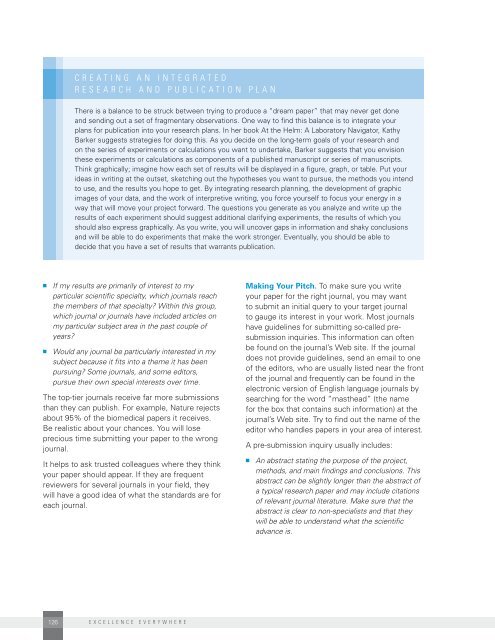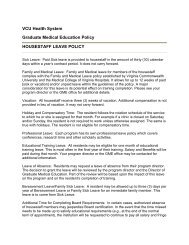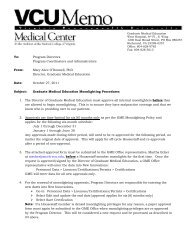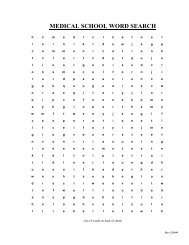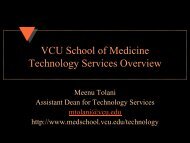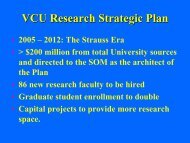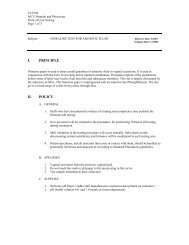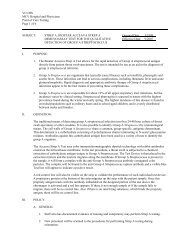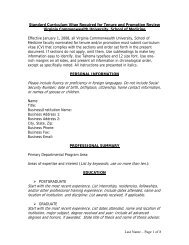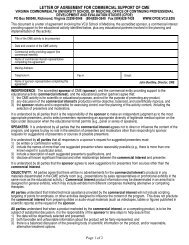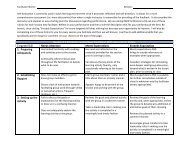C r e a t i n g a n i n t e g r a t e dresearch and publication planThere is a balance to be struck between trying to produce a “dream paper” that may never get doneand sending out a set <strong>of</strong> fragmentary observations. One way to find this balance is to integrate yourplans for publication into your research plans. In her book At the Helm: A Laboratory Navigator, KathyBarker suggests strategies for doing this. As you decide on the long-term goals <strong>of</strong> your research andon the series <strong>of</strong> experiments or calculations you want to undertake, Barker suggests that you envisionthese experiments or calculations as components <strong>of</strong> a published manuscript or series <strong>of</strong> manuscripts.Think graphically; imagine how each set <strong>of</strong> results will be displayed in a figure, graph, or table. Put yourideas in writing at the outset, sketching out the hypotheses you want to pursue, the methods you intendto use, and the results you hope to get. By integrating research planning, the development <strong>of</strong> graphicimages <strong>of</strong> your data, and the work <strong>of</strong> interpretive writing, you force yourself to focus your energy in away that will move your project forward. The questions you generate as you analyze and write up theresults <strong>of</strong> each experiment should suggest additional clarifying experiments, the results <strong>of</strong> which youshould also express graphically. As you write, you will uncover gaps in information and shaky conclusionsand will be able to do experiments that make the work stronger. Eventually, you should be able todecide that you have a set <strong>of</strong> results that warrants publication.n If my results are primarily <strong>of</strong> interest to myparticular scientific specialty, which journals reachthe members <strong>of</strong> that specialty? Within this group,which journal or journals have included articles onmy particular subject area in the past couple <strong>of</strong>years?n Would any journal be particularly interested in mysubject because it fits into a theme it has beenpursuing? Some journals, and some editors,pursue their own special interests over time.The top-tier journals receive far more submissionsthan they can publish. For example, Nature rejectsabout 95% <strong>of</strong> the biomedical papers it receives.Be realistic about your chances. You will loseprecious time submitting your paper to the wrongjournal.It helps to ask trusted colleagues where they thinkyour paper should appear. If they are frequentreviewers for several journals in your field, theywill have a good idea <strong>of</strong> what the standards are foreach journal.Making Your Pitch. To make sure you writeyour paper for the right journal, you may wantto submit an initial query to your target journalto gauge its interest in your work. Most journalshave guidelines for submitting so-called presubmissioninquiries. This information can <strong>of</strong>tenbe found on the journal’s Web site. If the journaldoes not provide guidelines, send an email to one<strong>of</strong> the editors, who are usually listed near the front<strong>of</strong> the journal and frequently can be found in theelectronic version <strong>of</strong> English language journals bysearching for the word “masthead” (the namefor the box that contains such information) at thejournal’s Web site. Try to find out the name <strong>of</strong> theeditor who handles papers in your area <strong>of</strong> interest.A pre-submission inquiry usually includes:n An abstract stating the purpose <strong>of</strong> the project,methods, and main findings and conclusions. Thisabstract can be slightly longer than the abstract <strong>of</strong>a typical research paper and may include citations<strong>of</strong> relevant journal literature. Make sure that theabstract is clear to non-specialists and that theywill be able to understand what the scientificadvance is.126 excellence everywhere
n A cover letter briefly describing what questionsled you to your research project, what you did, whyyou think your findings or methodology are significant,how your findings advance the field, and whythey are <strong>of</strong> special interest to that journal’s readers.Limit the cover letter to no more than 500 words.If English is not your first language and you arepitching your manuscript to an English languagejournal, make sure the abstract and cover letterare clearly written and that there are no grammaticalerrors. There are many companies thatspecialize in editing English manuscripts writtenby authors who are strongest in other languages.Their services are expensive, but having the input<strong>of</strong> people with good command <strong>of</strong> a language youmay not know perfectly can make the differencebetween a paper being read or not read by theeditors. If you have a colleague who is a goodwriter, has English as a first language, and iswilling to help you, take advantage <strong>of</strong> the <strong>of</strong>fer.Remember to thank him or her in the acknowledgementssection <strong>of</strong> the paper.Pre-submission inquiries are typically consideredwithin a few days at the top-tier English languagejournals, but consideration times can vary widelyfrom journal to journal. When making yoursubmission, it is fine to email the journal’s editorto ask about the expected time frame for reviewingthe manuscript and accepting or declining thesubmission. When that time has elapsed, followup with a telephone call or email to the editor. Ifyou make this second contact by phone, use theopportunity to make your pitch a second timeusing the same kind <strong>of</strong> persuasive arguments youused in your cover letter. Be sure to allude to thelarger context <strong>of</strong> your research—the big picturethat makes your particular effort meaningful.You can expect a reply <strong>of</strong> either “we’re notinterested” or “send the full manuscript.” Apositive response to a pre-submission inquiry isnot a guarantee that the manuscript will be sentout for formal peer review. The editor will want tosee the actual paper before making that decision.writing your paperOnce you have decided where you want to submityour manuscript, review the journal’s editorialguidelines (available from the journal’s Web site ordirectly from the editor) and follow them carefully.Pick the type <strong>of</strong> paper that is most appropriate forthe story you want to tell. For example, a “note”might be described by a journal as a 1000-wordpaper with no more than three figures, while a“report” might be one <strong>of</strong> 5000 words and up totwelve figures. Which fits your data morecomfortably? You might think <strong>of</strong> each figure asa distinctive verse in a song. Are you singing aquick, light tune, or a lengthy historical ballad?Either size <strong>of</strong> paper is good, but you want tochoose the right size before you proceed.Once you have decided what kind <strong>of</strong> paper to write,print or make copies <strong>of</strong> a few different examples<strong>of</strong> that kind <strong>of</strong> paper from the journal and analyzethem. How much room does each devote to theintroduction? Is the methods and materials sectionfinely detailed or nearly perfunctory? Is the discussionmixed in with the results or does it stand byitself? Summarize your analysis <strong>of</strong> the examplesand use the summary as a guide for outlining yourown paper.The main consideration when writing a paper is toclearly describe your most important findings andtheir impact in your field. Do not let your manuscriptlook like a compilation <strong>of</strong> lab data; makesure the reader can understand how you haveadvanced the field <strong>of</strong> research. But do not overdoit—claiming that your work is more important thanit really is earns little more than contempt fromreviewers.If you are the primary scientifically trained personinvolved in generating the data, write the paper’sfirst draft yourself. But if the data has been generatedby a student or scientist working under you,you might assign the task <strong>of</strong> writing the first draft<strong>of</strong> the paper to the student or scientist in yourlab who did the work. That person should be thefirst author and you should take the role <strong>of</strong> seniorauthor. In the life sciences, this is usually the lastname among the authors listed. If someone seniorto you at your institution will be senior author, youincreasing your impact: getting published127
- Page 3 and 4:
A R e s o u r c e f o r S c i e n t
- Page 5 and 6:
Table of ContentsVII119PrefaceChapt
- Page 7:
135 Chapter 10E x p a n d i n g Y o
- Page 15 and 16:
Q u e s t i o nq&aWhat Is a “Tenu
- Page 17:
preparing for immediate submission,
- Page 22 and 23:
Practicing the Talkn Practice your
- Page 24 and 25:
your one-on-one interviews you have
- Page 26 and 27:
If talking directly about money is
- Page 28 and 29:
When the institution responds and y
- Page 30 and 31:
equipment and supplies. Maintenance
- Page 32 and 33:
Q u e s t i o nq&aIs your instituti
- Page 34 and 35:
Working With Human SubjectsWhether
- Page 36 and 37:
RESPONSIBILITIES BEYONDTHE LABORATO
- Page 38 and 39:
UNDERSTANDING YOURINSTITUTION AND H
- Page 40:
Criteria for PromotionStructure of
- Page 45 and 46:
Q u e s t i o nWhat’s in a Name?q
- Page 47 and 48:
Screening ApplicantsWhen you review
- Page 50 and 51:
Interpersonal Skillsn How important
- Page 52 and 53:
Multinational Organizations are hir
- Page 54 and 55:
n If there is an office that handle
- Page 57 and 58:
n Seek funding and publish papers (
- Page 59 and 60:
In fact, even though you yourself h
- Page 61 and 62:
n Craft a statement that you feel c
- Page 63 and 64:
n When you delegate authority to so
- Page 65 and 66:
n Use only pens, preferably with wa
- Page 67 and 68:
Strategy sessionsShould you decide
- Page 69 and 70:
Finding Good Papers for Journal Clu
- Page 71 and 72:
If possible, invite people in your
- Page 73 and 74:
Q u e s t i o nq&aHow do I avoid po
- Page 75 and 76:
The International Committee of Medi
- Page 77 and 78:
Managing Conflictin the LabConflict
- Page 79 and 80:
steps for dealing with conflictWhen
- Page 81 and 82:
chapter 5managing your time“ Succ
- Page 83 and 84:
Check your work: the 90-year though
- Page 85 and 86: n Make and keep appointments with y
- Page 87 and 88: n Help them seek advice without tak
- Page 89 and 90: FAMILY MATTERSMany scientists face
- Page 91 and 92: chapter 6project management“ We m
- Page 93 and 94: My project is to get a grant funded
- Page 95: ObjectivesObjectives are the end re
- Page 98 and 99: The key events schedule and the act
- Page 100 and 101: Microsoft Project, a program that s
- Page 102 and 103: Martin, Vivien. Managing Projects i
- Page 104 and 105: appendix II: Example of a Work Brea
- Page 106 and 107: appendix iv: Example of a Gantt Cha
- Page 108 and 109: e h i n d c l o s e d d o o r s :w
- Page 110 and 111: Who might be interested in supporti
- Page 112 and 113: Call your program officerProgram of
- Page 114 and 115: direct costs vs. indirect costsDire
- Page 116 and 117: RESOURCESAllen, Ernest M. “Why ar
- Page 118 and 119: the next generation of students (th
- Page 120 and 121: Seek Feedback through a Formal Peer
- Page 122 and 123: Encouraging Student Questionsn Do n
- Page 124 and 125: Here are some ways you can help the
- Page 126 and 127: n Are there curriculum changes unde
- Page 128 and 129: a relaxed format for talking about
- Page 130 and 131: spend in preparing an effective cou
- Page 132 and 133: The Publishing ProcessTypes of Jour
- Page 134 and 135: A word about impact factorsThe impa
- Page 138 and 139: may need to take the first author p
- Page 140 and 141: submitting image filesToday, most i
- Page 142 and 143: Submitting your Paper to Another Jo
- Page 144 and 145: RESOURCESDavis, Martha. Scientific
- Page 146 and 147: increase your impact as a scientist
- Page 148 and 149: Q u e s t i o nq&aHow do I communic
- Page 150 and 151: n Offer criticism and correction in
- Page 152 and 153: It is important to discuss career g
- Page 154 and 155: When Mentoring,Advisory, or Supervi
- Page 156 and 157: For researchers in developing count
- Page 158 and 159: n Is travel safe and convenient, or
- Page 160 and 161: n The expected contribution of each
- Page 162 and 163: Meetings. Set up systems to ensure
- Page 164 and 165: SPECIAL CHALLENGESFOR THE BEGINNING
- Page 166 and 167: e an important connection to future
- Page 168 and 169: The invention of a new method or pr
- Page 170 and 171: licensee, who can charge others for
- Page 172 and 173: Most profound for developing countr
- Page 174 and 175: Finally, the patents have been chal
- Page 176 and 177: And, India benefited as a supplier
- Page 178 and 179: paperwork involved in purchasing1.
- Page 180 and 181: labeling mattersA case in point: In
- Page 182 and 183: equipment, freeze-drying equipment,
- Page 184 and 185: Responsibilityfor materialsIf an or
- Page 186 and 187:
Recent Improvementsin Materials Tra
- Page 188 and 189:
“Knowledge is power.” —Sir Fr
- Page 190 and 191:
MOUMemorandum of UnderstandingRFPRe
- Page 192 and 193:
notes continued182 excellence every
- Page 194:
notes continued184 excellence every


